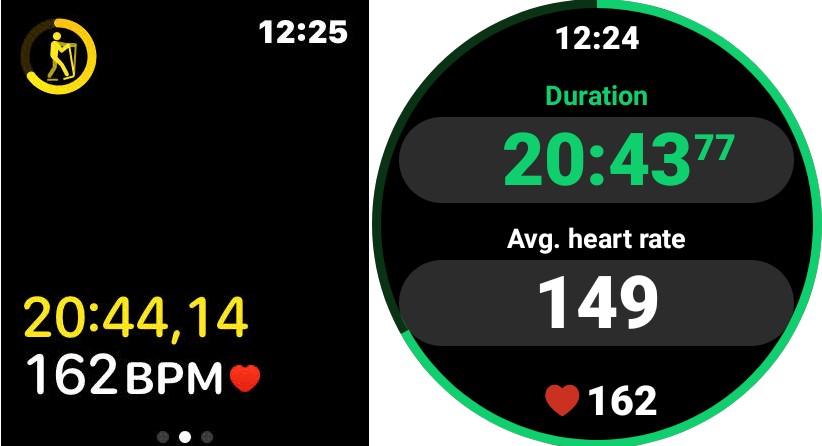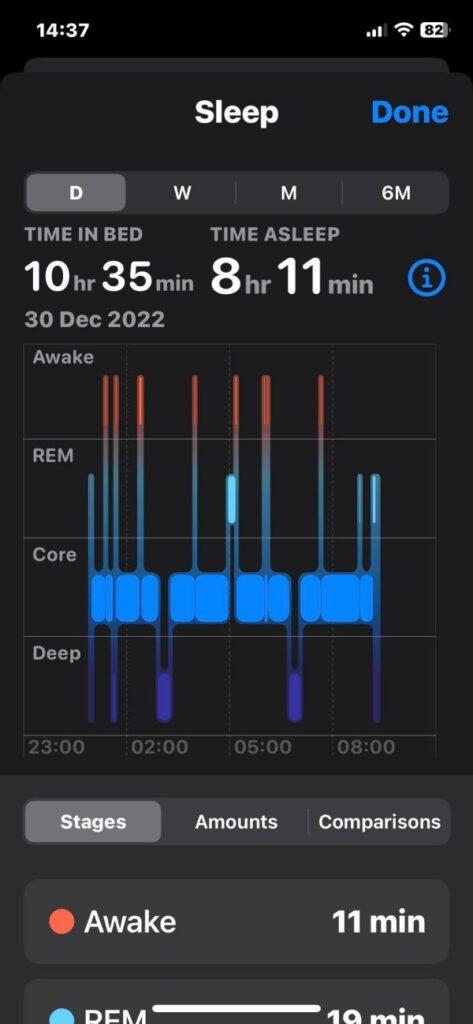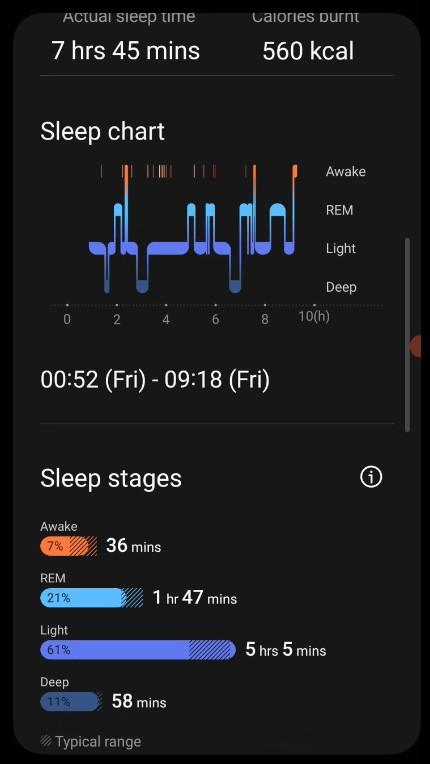Both smartwatches are actually very good, in fact, pretty much on par with each other as I discovered, but another thing that both watches have in common is, that you really need their matching brand phone to fully use them effectively. This is even more true for the Apple option. So the easy answer to which smartwatch is the best option to choose, is really based on what phone you are using (which is why when I decided to buy an Apple Watch, I also had to ditch my Pixel phone for an Apple iPhone.
This is what prompted my purchase of a Samsung Galaxy Watch 5 (not Pro model) because I have just switched out my iPhone 12 Pro for a super budget Galaxy A13 phone (that will be another future post after March 2023 as I’m waiting to whether I should get a new Galaxy S23). So although the Samsung watch was fairly similar to the Apple watch, I set out to do a more detailed comparison between the two, to see whether I had buyer’s remorse or not.
Certainly on an objective accuracy level, the Apple Watch has been shown to be a shade more accurate than the Samsung Watch, as can be seen from the test results on the ‘The Quantified Scientist’ YouTube channel, but the differences are quite small in real terms, with both watches scoring very well (apart for deep sleep, and some under reading of SpO2, on the Galaxy Watch 5).
Superficially the Apple Watch is square with the non-LTE 45 mm version costing about $370, and the Samsung Watch 5 non-LTE 44 mm one has a round face and costs around $270 (Pro model about $449). The Watch 5 Pro really only has the slightly bigger battery (3 days of use instead of 2), and the Titanium case, so I did not think it worth spending $160 extra for that. The Apple Watch uses its crown to rotate through options, whilst the Galaxy Watch now uses a digital dial which is in the bezel area around the screen.

On features both have:
* Plenty of customisable watch faces with complications (showing additional details), and Samsung has a toggle to activate ticking sounds for faces which support that.
* Software updates for multiple years – Apple 5 and Samsung for 4 years.
* Health stats: ECG (both FDA approved), always-on heart rate monitoring (both with low and high alerts), SpO2, walking asymmetry (Samsung is limited to the running exercise for this). Both have fall detection, and panic button presses, with notification for emergency contacts.
* Apple has in addition also walking asymmetry, double support time, walking steadiness, and respiratory rate, noise level monitoring, and actual HRV (HRV inverse correlates to stress levels).
* Samsung has in addition Stress Level monitoring (continuous or manual, which is a form of HRV measuring, which measures the activities/arousal of the autonomic nervous system), a Body Composition Measurement for fat mass, skeletal muscle, body fat (shows 1.2% difference from my Fitbit Aria scale), BMI, body water (hydration), and BMR; as well as a built-in snore detection with optional audio recordings. It also has a skin temperature sensor which has not yet been activated by Samsung. There are also 3rd party apps that provide HRV measurements, and I’ll show one in my video. Samsung also has blood pressure monitoring, and although requiring re-calibration every 28 days, the tests on the ‘The Quantified Scientist’ YouTube channel show some reasonable correlation to actual blood pressure readings.
* Neither have website views of their health stats. I’ll also show video of what both health apps look like in my YouTube video.
* Various iOS apps sync health data via Apple Health, and on Samsung they sync via Health Connect service.
* Both OEMs will replace the battery for a fee.
* Both watches have GPS and compass. The Galaxy 5 Pro version can import a GPX map and give directions to stay on route, and do trackback (but 3rd party apps like Strava or Map My Run may achieve the same for a fee).
* Apple Watch has a trackback GPS feature (that does work more universally). On Samsung this is only supported for the Pro model, but as mentioned it could be activated through 3rd part apps.
On apps that I regularly used on my watch I did find no AllTrails nor Authy 2FA apps on the Android Wear OS. Although the Apple Watch has the Walkie-Talkie app that will only work on an Apple Watch, there is also a 3rd party walkie-talkie app called Kakoa Talk which works across Apple and Android. Both watches handled the Stocard and OurGroceries apps that I use. For SOS apps I had React SOS with a special deal in South Africa, but there appears to be no such monitored service for Android Wear OS watches in South Africa (on phones yes, but not watches). I should note though that the React SOS app was at times chewing through my Apple Watch battery time.
The app list is also worth mentioning as the Apple watch offers a choice between a name list or an icon list. Very oddly enough, the Galaxy Watch only provides an icon list, but I side-loaded a 3rd party app called Wear App Picker which provides such a name list of apps.
Both watches have swipe gestures for notifications and quick toggles, but only the Galaxy Watch also has a swipe to show many interactive tile views of various apps such as activity, month calendar, workouts, heart rate, stress level, SpO2, weather, etc. The closest Apple Watch has to this is the 5 quick-access apps that can be docked.
For NFC payments both have this capability. Samsung has since dropped it’s additional support for magnetic payments. Apple’s payment system was absolutely flawless with setup and use, and whilst the Galaxy Watch setup was fine, I twice had issues with its initial use. After removing, and re-adding the card, it worked fine the third time, and for subsequent purchases (it may be I was trying to initially enter the card PIN instead of Samsung Pay PIN though).
For workouts both have a lot of similar functionality, with Samsung though also having more than one custom screen with additional data (not sure that is really needed?), and the Galaxy Watch can add multiple routines in a sequence (again, is that really needed?). The Apple Watch by default was pausing a workout whenever I took a screenshot, but you can disable the pausing on pressing those buttons (odd that it allows the same button presses for screenshot as well as workout pause).
Regarding workout stats, the two screenshots below show an elliptical workout taken about 1 second apart, and you can see the same heart rate shown. I was wearing the Galaxy Watch on my left wrist, and the Apple Watch on my right wrist. They did vary sometimes by up to 2 or 4 beats per minute, but were otherwise fairly consistent with each other.

I spent about 3 charge cycles (2 days per cycle) comparing the battery usage across the watches. I did have to optimise quite a few settings on the Galaxy watch as its defaults are all set for best use, and least battery life. I’ll list these optimisations further down as they do give a good two days of use, with about 18% in reserve, without losing too much functionality. What I did like about the Galaxy Watch charging was that it showed the time left until fully charged. The Galaxy Watch was charging from around 20% to full in 70 minutes. A tip also is I tested that popping the Galaxy Watch on charge while I took a shower, added about 14% charge, so it’s a great way for a top-up if you have more features enabled. The Apple Watch is 22 months old whilst the Galaxy Watch is brand new. With Always-On display both watches would only get one day of use.

With both watches fully charged by midnight 00:00 and monitoring sleep (with SpO2 measurements) I would find next morning by 09:30 that the Galaxy Watch had used 11% battery and the Apple Watch 18% (when it was new I noted 8-10% use overnight. One difference at night is the Galaxy also has a Bedtime mode which prevents the display coming on when touched at night.
By the end of day two, with one exercise recorded in that time and two nights of sleep, the Galaxy Watch would have about 17% to 19% battery remaining, whilst the Apple Watch was around 18%. A lot will also depend on what sort of apps you have running eg. Sleep for Android can poll the watch via Bluetooth throughout the night, active GPS tracking during outside workouts will similarly use more battery. UPDATE: Since the end January 2023 OS update, day two has been ending at around 30-39% battery, so quite a big improvement!
Optimisations I made to max out battery life on the Galaxy Watch 5:
* WiFi off – the watch normally uses Bluetooth to sync with the phone when in range, so only needs WiFi if no phone and you wanted to connect to WiFi for Internet somewhere.
* Always-On display – set to off.
* Turn on screen for notifications – set to off.
* Lift wrist turns display on – set to off and can just tap screen or press button.
* Auto-Brightness – set to off with brightness set to about 25% and turns off after 15 seconds. May need auto-brightness on for outdoor use though.
* Bedtime mode – scheduled for my sleep time, it prevents any touches lighting the display.
* SpO2 – normally measures during sleep but uses about 3% extra battery during the night.
* Heart Rate measurements – I left it as always on 24/7 as the high/low warnings do not work if it is set to every 10 minutes for a reading.
* Animations – disabled and these only affect menu navigation and tiles, not watch faces.
* Vibrations/Haptics for system menus – set to off.
* Dark colour watch face – the OLED screen uses a lot less battery if the watch face is dark, and has less animated features.
* Exercises – for indoor elliptical workout the Galaxy Watch used about 10% battery for 35 minutes (maybe GPS was active?). That said on 30th Dec 2022 my exercise used 2% battery only (EDIT: And again on 5 Jan 2023 only 2%), and the Apple Watch on 30th Dec 2022 used 4% battery.
* Auto detection of workouts / Inactivity Alerts – off, the theory being it does not analyse the motion sensors all the time.
* Stress measurement – I set it to hourly readings.
* Notifications – left sound and vibration on, but only included essential apps for notifications on watch.
When it came to sleep tracking I could compare the two watches also to my Oura Ring. The Oura Ring is specifically intended for sleep analysis. From other test results seen I was expecting the Galaxy Watch to be a bit over sensitive to showing wake periods. So for the night of 29-30 Dec 2022 these are the stats shown (I would be in bed reading from about 23:15 so 10 hours in bed in total, and attempting to sleep from 00:45 so sleep time is about 08:35 hours from 00:45 until 09:20):
* Oura Ring: Total bed time 08:32 (ACCURATE), Time asleep 07:21, Time awake 1:11, REM 01:45, Light 04:26, Deep 01:09, Efficiency 86%, Restlessness 45, Latency 7 mins, lowest resting HR 60 bpm, average resting HR 65 bpm, respiratory rate 13.4 /min, and temperature deviation -0.5C.
* Apple Watch: Time in bed 10:35 (Lying down reading I imagine), Time asleep 08:11, Awake 11 mins, REM 19 mins, Core (Light) 7 hrs, Deep 46 mins, Restlessness 07:08 (3rd party app) average resting HR 64 bpm with range 55-77 bpm (3rd party app).
* Samsung Watch: Total sleep time 08:26 (00:52-09:18), Actual sleep time 07:45, Time awake 36 mins, REM 01:47, Light 05:05, Deep 58 mins, Efficiency 97% , Score 81.
| Metric | Oura | Apple | Samsung |
| Total | 8h32 | 10h35 | 8h26 |
| Asleep | 7h21 | 8h11 | 7h45 |
| Awake | 1h11 | 11 mins | 36 mins |
| REM | 1h45 | 19 mins | 1h47 |
| Light | 4h26 | 7 hrs | 5h05 |
| Deep | 1h09 | 46 mins | 58 mins |
| Efficiency | 86% | 97% | |
| Restlessness | 45 | 7h08 | |
| Latency | 7 mins | ||
| Lowest Rest HR | 60 bpm | 55 bpm | |
| Ave Rest HR | 65 bps | 64 | |
| Respiratory Rate | 13.4 /min | ||
| Temp Dev | -0.5C |
So all in all actually the Samsung Watch is a lot closer, across most sleep metrics, to the Oura Ring than the Apple Watch is (but I was wearing the Apple Watch on my right arm, whilst other devices were both on my left arm, and a more scientific test at https://youtu.be/LPqtfC70QTU does show the Apple Watch as clearly better on sleep tracking)! For comparison here are similar tests done for the Galaxy Watch 5 at https://youtu.be/78A3rTdBHbk.



Obviously mileage is going to vary for everyone as conditions differ, ages of devices differ, apps installed, and these were certainly not scientifically calibrated in any way. Also I only did about 6 days of testing and should have done a longer period with more detailed analysis for multiple days. As it is I’m a bit surprised that I see now my sleep results for the Samsung show a closer correlation to the Oura Ring than the Apple Watch did. One could say the Oura Ring is not that good (although a case is made that measurements on the finger are more accurate, and the Oura Ring is designed more specifically for sleep stats and used in medical research studies).
But as I said it was more a superficial comparison for my own purposes. This comparison is not at all intended to try convince anyone to switch away from the watch they are currently using. And as I initially stated, your choice of using an iPhone or an Android phone, will be the primary consideration for choosing either of these watches.
My YouTube video (due in the next few days) on this same topic will delve a bit more into video views of the screens, and will be of interest to those who would like to see what the Samsung Health and Apple Health apps look like when viewed on the phones.


One thought on “Why I migrated from an Apple Watch to a Samsung Galaxy Watch 5”
Comments are closed.